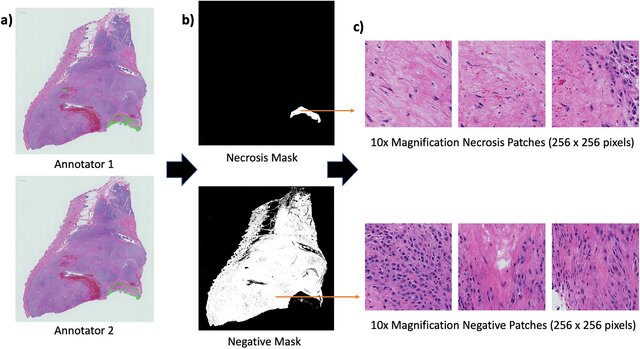Revolutionizing Veterinary Oncology: AI’s Role in Detecting Necrosis

The landscape of veterinary oncology is undergoing a significant transformation, thanks to the advent of artificial intelligence (AI). A groundbreaking study has unveiled a novel approach to detecting necrosis in canine soft tissue sarcomas (cSTS), including Perivascular Wall Tumours (cPWTs), using deep learning AI. This advancement promises to enhance the accuracy of tumor grading, a crucial factor in determining the most effective treatment options for our canine companions.
The Challenge of Necrosis Detection
Necrosis, or the presence of dead cells caused by disease or injury, is a key indicator in assessing the severity and stage of tumors. Traditionally, this assessment has been performed manually by pathologists, a process fraught with variability that can lead to inconsistencies in tumor grading. The precision of these grades is vital, as they directly influence treatment decisions and, ultimately, patient outcomes.
A Leap Forward with AI
Enter the realm of deep learning, a subset of AI that has demonstrated remarkable success in interpreting complex data, including medical images. The study in focus employed a patch-based deep learning model utilizing the DenseNet-161 Convolutional Neural Network (CNN) architecture. This approach has not only showcased AI’s potential in automating the detection of necrosis in histopathology Whole Slide Images (WSIs) but also marked a significant step towards eliminating the subjectivity associated with manual grading.
Breakthrough Findings
The optimised DenseNet-161 model achieved a hold-out test F1-score of 0.708, indicating state-of-the-art performance. This achievement represents the first successful attempt at automating necrosis detection in the domain of cSTS and cPWTs, offering a promising solution to the challenge of inter-operator reproducibility in tumor grading.
Implications for Veterinary Oncology
The implications of this study are profound. By improving the precision of tumor grading, AI-driven necrosis detection paves the way for more accurate and consistent treatment planning. This not only benefits veterinary professionals by providing them with reliable diagnostic tools but also enhances the quality of care available to our pets.
Towards a Brighter Future in Pet Healthcare
This research exemplifies the incredible potential of AI to transform veterinary oncology, making it a beacon of hope for pets diagnosed with cancer. As AI continues to evolve, its integration into veterinary medicine promises to bring about more innovations that will further refine diagnostic and treatment processes.
Explore the Full Study
For veterinary professionals, researchers, and anyone interested in the intersection of technology and pet healthcare, this study offers valuable insights into the future of veterinary oncology. We invite you to delve deeper into the methodology, findings, and implications of this pioneering research by reading the full paper.